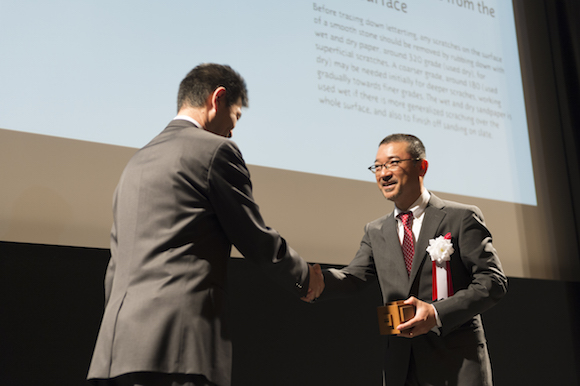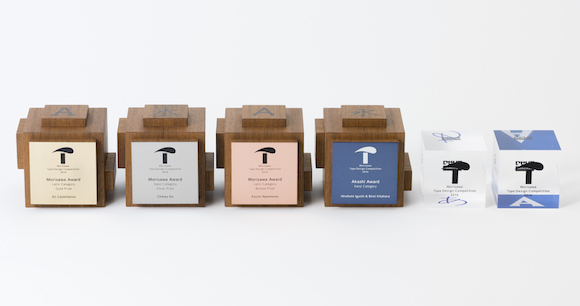
Morisawa Inc. held its Type Design Competition 2014 Awards Ceremony on Friday, March 20, 2015, at the UDX Theater in Akihabara, Tokyo.
The Morisawa Type Design Competition 2014, a font design contest hosted by Morisawa Inc., drew a combined total of 386 entries (Kanji and Latin categories) from 24 countries around the world. The screening process, held in November 2014, yielded a total of 17 awardees, who were presented with the Morisawa Award (Gold, Silver, and Bronze Prizes, plus three Honorable Mentions) for creativity and esthetics; the Akashi Award for entries that demonstrate the potential to be commercialized by Morisawa; and the People’s Choice, based on the number of fan votes collected via the Web. Eleven of the 17 attended the ceremony.

In his opening address, Morisawa Inc. President & CEO Akihiko Morisawa conveyed his appreciation to those who submitted entries to the competition, and congratulated the award recipients. He added that 2014 had been a special year for Morisawa: “Morisawa has its roots in phototypesetting machine development, and 2014 marks the 90th anniversary year of the first phototypesetting machine. It was also the 30th anniversary of the Morisawa Award International Typeface Design Contest, which was the predecessor of the Morisawa Type Design Competition.” On the subject of changes in the font environment that have occurred over the decades since, Morisawa added, “At the time of the first International Typeface Design Contest, fonts consisted mainly of those printed in ink on paper, but later, with the advent of the Internet and various different kinds of devices, kanji (Chinese characters) and alphabetical characters came to be represented more and more on computer screens.” In closing, he remarked—based on the company’s stated mission—that he would like to see Morisawa “do its part for the further development of characters used in various devices and media, as well as to the world culture of literacy.”
The Awards Ceremony began with the Morisawa Award Kanji Category. The presenter was Matthew Carter, judge of the Latin Category and all-around jury president.

Koichi Namimoto, winner of the Gold Prize for “Wakatsuki Maru Gothic”; Chikao Ito, winner of the Silver Prize for “In Ei Ming-cho-tai”; Giichi Okazaki, winner of the Bronze Prize for “Cho-yo”; and Tomomi Kanda, who received Honorable Mention for “Harmony,” were welcomed with a big round of applause, while Carter presented them their respective trophies. In the Latin Category, Eli Castellanos was given the Gold Prize for “Hola”; Maria Doreuli the Silver Prize for “Chimera”; Koichi Namimoto the Bronze Prize for “Kulin”; and Kunihiko Okano Honorable Mention for “Alcedo.”

President Tsunehisa Morisawa of Morisawa Bunken Inc. presided over the Akashi Awards, which were presented to Hirofumi Iguchi and Birei Kitahara in the Kanji Category for “Kitahara Gyosho,”and to Koichi Namimoto in the Latin Category for “Kulin.” When Namimoto was presented with his certificate and trophy—and it was announced that he had placed in both the Morisawa Award Kanji and Latin Categories—the hall broke out in a tremendous round of applause.

Morisawa Inc. President and CEO Akihiko Morisawa presented the People’s Choice trophies to Sanae Harayama, first place winner in the Kanji Category for “Go-yo-tai,” and to Aki Toyoshima, second place winner for “En-so-ku.”
Matthew Carter gave a general evaluation at the end of the ceremony, but first expressed his appreciation for being given the opportunity to present the awards and trophies to the recipients. He added, “This is the sixth time for me to serve as a judge in the Morisawa Type Design Competition Latin Category, and though I have seen many wonderful pieces over the past 20-plus years, the Morisawa Type Design Competition 2014 contained some of the best ever. Though the number of entries was not the largest we have ever had, there were some that were of extraordinary quality, and there was also a great deal of variation. The screening was extremely strict, and in many instances we held extended discussions to determine which pieces should receive the awards. It was an extremely arduous process this time, and I would like to emphasize the fact that the winning works had to go through this process.” Next, he commented as follows on what stood out for him about the Morisawa Type Design Competition 2014 winners, which were of a great variety of font styles.

“Our entries this time demonstrated an incredible degree of variation in style. In the Latin category, applicants were free to submit works in serif, sans-serif, script, and more, and I believe it was clear that the judges were fair and flexible in their evaluation of these works. I would like to convey this fact to all of our applicants, as well as to all future Type Design Competition applicants.”
To close the ceremony, Carter added that the purpose of the type design competition was to train up-and-coming type designers, and that he looked forward to “the continuation of this tradition” in the form of the Morisawa Type Design Competition.
So far held in 2012 and again in 2014—two years apart—the next Morisawa Type Design Competition is slated for 2016.

Trophies
